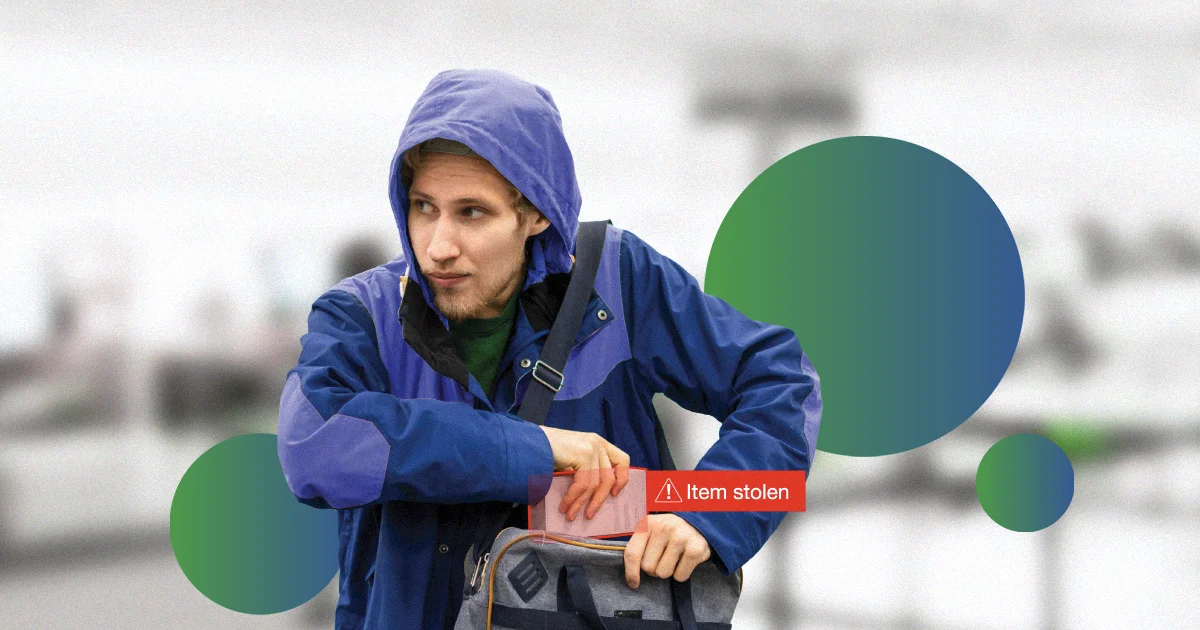But it’s not just the loss of revenue that has made shrink such a hot topic: missing products are a customer experience nightmare. There’s no quicker way to send shoppers into the arms of a competitor than by not having an item available — especially if your website says it’s in stock. As a result, finding and controlling the causes of shrink is as much a customer experience issue as a stock management one. So let’s take a closer look at what it is and what it takes to get it under control.
Since shrink is a measurement covering products missing for any reason, there are many potential root causes, each requiring a different approach.
Perhaps not surprisingly, customer theft is one area that has seen a noticeable increase over the last few years. Rising inflation and other cost-of-living pressures are encouraging more petty theft, while the rise of marketplaces has made it even easier for organized retail crime (ORC) to move stolen goods. Although not restricted to the United States or the UK, both countries have seen campaigns, led by the NRF and Mail Online respectively, designed to introduce harsher penalties for shoplifting, particularly for repeat offenders and violent or abusive incidents.
Many retailers are currently addressing this issue by locking items in cabinets, increasing tagging, removing self-checkouts or closing heavily afflicted stores. However, there’s a problem with these measures — they make in-store shopping more inconvenient. Instead, some less instructive tactics you could adopt include:
It may seem simple, but by just having store associates greet customers when they walk through the door you send a message to potential shoplifters that staff are keeping an eye on what they’re doing. As a bonus, this can also improve customer satisfaction and sales — depending on your country, region and clientele.
For items that need to be restricted for safety or security reasons, having smart call points that send detailed notifications to employee headsets is a great way to speed up customer waiting times while still ensuring you’re compliant. Additionally, using headsets that can also integrate with your self-checkouts would allow store associates to receive a range of notifications, letting them know about issues even when they’re in the stockroom. This helps reduce waiting times and ensure that employees are always aware when self-checkouts are in use, giving them more opportunities to check for human error or nefarious activity.
These methods, however, only deal with specific areas of the store. AI theft detection, on the other hand, employs software that scans your security footage in real-time to identify suspicious gestures and send alerts when a theft’s been detected. The alerts could be sent over a PA system to discourage would-be thieves or — once again — through headsets so that staff can discretely investigate the situation, challenge suspicious behavior and/or replenish stock before it affects other shoppers.
A more elaborate type of customer theft, return fraud can take various forms including, but not limited to:
While it seems incredulous that people can — and do — make a return claim for stolen items, it’s a surprisingly easy process. Stores that have liberal return policies or employees that don’t check for proof of purchase, allow thieves to claim money for nothing. For those stores with stricter policies, savvier fraudsters create counterfeit receipts or pick up discarded ones near the tills so that they have proof of purchase even when the item was never actually paid for.
The same methods aren’t only used for items stolen from the store itself but also for items purchased at a lower price from another retailer, individual or marketplace. And of course, we’ve likely all heard of or know someone who has worn an outfit to an event, with the tags carefully hidden, just so they can return it the next day. While it may seem unfair to a shopper that they have to pay full price for an item they may only intend to use once, is still a form of return fraud.
It’s not just customers who are eyeing your stock — often it’s your employees as well. While employee theft can manifest as a staff member taking an item or money from the store, it’s more likely to be something that’s harder to spot such as helping friends and family by not scanning products properly, applying heavy discounts or mishandling returns.
Just like with return fraud, the most effective way to combat this type of loss is training. But beyond making sure staff know store policies, you need to have a look at the overall employee experience. Store associates who are happy and feel like valued members of the team are less likely to steal so ensuring that they are paid well, offered training and advancement opportunities and can access support through every shift is vital. As an additional bonus, happy employees are also more likely to offer friendly and helpful customer service, helping you to not only increase staff but customer loyalty at the same time.
That’s right — your stock numbers can be off before customers or staff ever see the product. Some unscrupulous vendors will raise fraudulent orders, send damaged goods or fail to deliver everything on the delivery note, causing you to have less stock in your building than you planned. While some of these issues can be down to human error, it’s important to have clear processes that include physically checking deliveries the moment they arrive in store. The sooner problems are detected the easier it is to raise the issue with the supplier, allowing them to rectify the solution.
When it comes to identifying these issues, time is often of the essence. Making sure your employees can quickly communicate across departments gives you the best chance to identify these issues and/or share information with the sales team. Quick communication among store associates gives customer-facing employees the chance to readjust their displays and think of alternative products so that when mistakes do happen, it impacts customers minimally.
Not all loss is suspicious — or on purpose. Whether it’s from miscounting items, clerical errors or forgetting to scan everything at checkout, human errors can creep into the system throwing off your inventory count.
The best way to reduce these errors? Again, training and communication are key, but reducing the amount of repetitive tasks through automation decreases the opportunity for mistakes. In addition, clear procedures — especially when it comes to product location and logging — make it clear to employees what they need to do, reducing the chance errors will creep in from different methods and approaches.
Perhaps the least exciting of all the causes of shrink is operational loss. These are the things that are generally considered as part of the cost of doing business. Breakages, supply chain disruptions and expired products are impossible to completely avoid, but they can be mitigated.
With smart fridges, the temperature of food products can be continuously monitored, helping stores avoid spoilages or worse, food-borne illnesses. Retail headsets can help store associates at checkouts ask for support in running abandoned chilled products back to the fridge or freezer, extending the shelf life of the product. And with breakages, encouraging employees throughout the store and returns to submit reports can help identify if the product is faulty or if there’s another issue at fault, such as the type of shelf or display, giving your teams the information they need to enact changes that will lead to fewer damaged items.
As you can see, despite the current focus on shoplifting and organized crime, theft is only part of the problem. To truly address shrink and protect your bottom line you need to do more than restrict access to products, you need to streamline procedures and connect your teams.
So, what’s the best tool to help you with this? In our experience x‑hoppers, the complete retail headset system, is the only solution that offers everything your store needs to help reduce shrink. More than just headsets, x‑hoppers connects store associates to store systems, including smart call points, AI theft detection and self-checkouts, helping you identify and manage the causes of shrink before they get out of hand.
But whatever software, tools or procedures you decide to use, make sure that you have a clear plan of how to communicate and engage your team. Because only when you share information quickly from systems, the back office and the shop floor can you implement lasting change.







